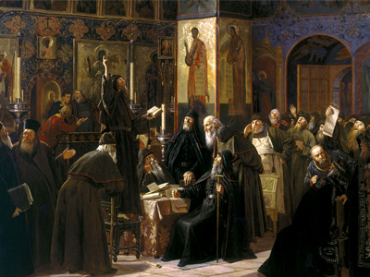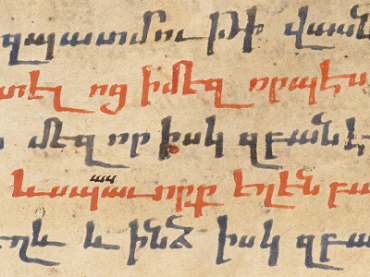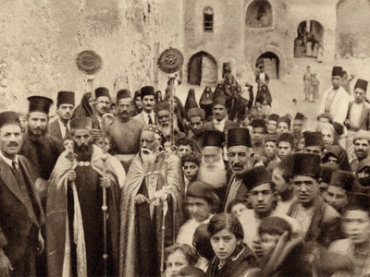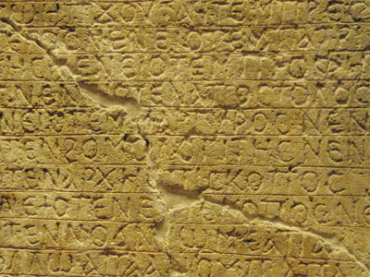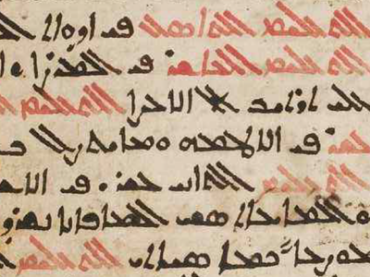Syriac and Eastern Christianity
The Web of Religion and Science
Bellah, Habermas and Giddens
By Hanan Reiner
Series: Gorgias Studies in Religion 21
ISBN: 978-1-4632-0398-6
Scholars from various fields of study have long dealt with the relationship between religion and science. This subject has found a particular expression in sociology. Sociologists and other scholars agree that even though religion and science can be seen as separate from each other, there are several commonalities between the two. The common ground between Bellah, Giddens, and Habermas – the meaningful position the Subject has/should have in constructing the social reality – brings to light a transition in the sociological theoretical arena, if we take into account the different theoretical roots of each scholar – Functionalism (Bellah), Positivism (Giddens), and Neo-Kantian (Habermas).
$55.00
The Filioque Impasse
Patristic Roots
ISBN: 978-1-4632-0403-7
A fascinating study of the underlying reasons for the disagreement over the clause “and the Son” in the Western version of the Niceno-Constantinopolitan creed, which contributed to the schism between Eastern and Western Christians. Coetzee argues that there has been a great deal of misunderstanding of the positions of each tradition by the other, partly due to the fact that East and West imbue certain key words, such as ‘person’ and ‘unity’, with different meanings which Coetzee believes come from different understandings of Hellenic philosophy. Against this backdrop, Coetzee sets about clearing up some of the misunderstandings.
$99.00
Neo-Aramaic and its Linguistic Context
Edited by Geoffrey Khan & Lidia Napiorkowska
Series: Gorgias Neo-Aramaic Studies 14
ISBN: 978-1-4632-0410-5
This volume contains papers on the Eastern Neo-Aramaic dialects and the languages in contact with them. The papers make important contributions to the documentation of the dialects and to the understanding of their development in the context of non-Semitic contact languages.
$206.00
Icons of the Heavenly Merchant
Ephrem and Pseudo-Ephrem in the Madrashe in Praise of Abraham of Qidun
By Andrew Hayes
Series: Gorgias Eastern Christian Studies 45
ISBN: 978-1-4632-0414-3
A detailed study of a cycle of fourth-century liturgical poems, in Syriac, dedicated to a great pioneer of the Syriac ascetical tradition. Hayes analyzes its various portraits of the saint, shaded differently by Ephrem and his later imitators.
$187.00
An East Syrian Manuscript of the Syriac 'Masora' Dated to 899 CE (Volume 2)
Introduction, List of Sample Texts, and Indices to Marginal Notes in British Library, Additional MS 12138
Prepared by Jonathan Loopstra
ISBN: 978-1-4632-0391-7
This unique manuscript of the East Syrian Syriac ‘Masora’ is essential for any study of early Syriac vocalization, accentuation, and punctuation. In Volume 1, Gorgias Press has published a facsimile reproduction of this unique ‘masoretic’ manuscript. This volume (Volume 2) includes an introduction and comprehensive lists of all scriptural sample texts and marginal notes in this compilation.
$228.00
The Martyrs of Mount Ber'ain
Edited and Translated by Sebastian P. Brock; Introduction by Paul C. Dilley
ISBN: 978-1-4632-0421-1
The Martyrs of Mount Ber’ain is the poignant tale of three noble Iranian siblings who are martyred under Shapur II. Composed in the seventh century, it demonstrates enduring concerns of Christian self-definition in Iran, especially with respect to the Zoroastrian priesthood.
$43.00
Jacob of Sarug's Homilies on Women Whom Jesus Met
Edited and Translated by Susan Ashbrook Harvey, Sebastian P. Brock, Professor Reyhan Durmaz, Rebecca Stephens Falcasantos, Michael L. Payne & Prof. Daniel Picus
Series: Texts from Christian Late Antiquity 44
ISBN: 978-1-4632-0580-5
Five homilies by Jacob of Sarug on women whom Jesus met: the Canaanite Woman, the Samaritan Woman, the Hemorrhaging Woman, the Woman Bent Double, and Jairus' Daughter.
$37.00
Syrians and the Others
Cultures of the Christian Orient in the Middle Ages
Edited by Basil Lourié & Nikolai N. Seleznyov
ISBN: 978-1-4632-0424-2
The volume contains the first editions of a number of works of Syrian authors and a publication of Coptic liturgical texts. It also includes a discussion of the letters of Nicetas Stethatos available only in Georgian and other patristic/hagiographical topics.
$216.00
Journal of the Canadian Society for Syriac Studies 14
Edited by Amir Harrak
ISBN: 978-1-4632-0469-3
A refereed journal published annually by the Canadian Society for Syriac Studies. Volume 14 includes articles by Aaron Butts, Istvan Perczel, Emanuela Braida, Hikmat Bashir al-Aswad, and Nasir al-Ka'bi.
$75.00
The Syriac Writers of Qatar in the Seventh Century
Series: Gorgias Eastern Christian Studies 38
ISBN: 978-1-4632-0524-9
The Syriac writers of Qatar themselves produced some of the best and most sophisticated writing to be found in all Syriac literature of the seventh century, but they have not received the scholarly attention that they deserve in the last half century. This volume seeks to redress this underdevelopment by setting the standard for further research in the sub-field of Beth Qatraye studies.
$157.00
Orthodox Monasticism Past and Present
Edited by John A. McGuckin
Series: Gorgias Eastern Christian Studies 42
ISBN: 978-1-4632-0530-0
Studies in Eastern Orthodox monastic life and culture. Part 1 is devoted to New Testament, Patristic, and Byzantine foundations of eastern monastic theory, and Part 2 is comprised of contemporary reflections on Orthodox monastic life.
$230.00
An Anthology of Syriac Writers from Qatar in the Seventh Century
Series: Gorgias Eastern Christian Studies 39
ISBN: 978-1-4632-0545-4
The Syriac writers of Qatar have not received the scholarly attention that they deserve in the last half century. This anthology seeks to redress such an underdevelopment by providing new material in English translation with accompanying Syriac and Garshuni editions to encourage further research in the sub-field of Beth Qatraye studies. It includes the work of some of the most prominent scholars in this field.
$25.00
Daniel According to the Syriac Peshitta Version with English Translation
Translated by Donald M. Walter & Gillian Greenberg; Text Prepared by George Anton Kiraz & Joseph Bali
Series: Surath Kthob 25
ISBN: 978-1-4632-0546-1
This volume is part of a series of English translations of the Syriac Peshitta along with the Syriac text carried out by an international team of scholars.
$150.00
An Anthology of Syriac Writers from Qatar in the Seventh Century
Series: Gorgias Eastern Christian Studies 39
ISBN: 978-1-4632-0547-8
The Syriac writers of Qatar have not received the scholarly attention that they deserve in the last half century. This anthology seeks to redress such an underdevelopment by providing new material in English translation with accompanying Syriac and Garshuni editions to encourage further research in the sub-field of Beth Qatraye studies. It includes the work of some of the most prominent scholars in this field.
$110.00
Homily 33 on the Sanctification of the Church
Edited and Translated by Amir Harrak
Series: Texts from Christian Late Antiquity 54
ISBN: 978-1-4632-0552-2
Narsai’s memra 33 is made of 12 by 12 syllables, and its title “On the Sanctification of the Church” suggests that it was written for the feast of the Dedication of the Church celebrated by the Church of the East to this day on the first of November. The memra names the Church of the Nations the Bride of the Bridegroom Christ. The Church had a pagan origin but Christ chose her to become his bride. He thus saved her through his suffering, cleansed her with baptism, prepared the bridal feast for her through the Eucharist, and crowned her victory over all the nations.
$53.00
Altuigurische Texte der Kirche des Ostens aus Zentralasien
Old Uigur texts of the Church of the East from Central Asia
By Peter Zieme
Series: Gorgias Eastern Christian Studies 41
ISBN: 978-1-4632-0551-5
The book presents a full documentation of the Old Uigur texts of the Church of the East known from several places of Central Asia, mainly Bulayık and Kurutka in the Turfan oasis, as well as Xaraxoto, from the 10th to 14th century.
$164.00
Joshua According to the Syriac Peshitta Version with English Translation
Translated by Gillian Greenberg & Donald M. Walter; Text Prepared by George Anton Kiraz & Joseph Bali
Series: Surath Kthob 6
ISBN: 978-1-4632-0549-2
This volume is part of a series of English translations of the Syriac Peshitta along with the Syriac text carried out by an international team of scholars.
$150.00
The Vision of Theophilus
The Flight of the Holy Family into Egypt
Edited and Translated by Juan Pedro Monferrer-Sala
Series: Texts from Christian Late Antiquity 39
ISBN: 978-1-4632-0550-8
A critical edition of a fragmentary Arabic manuscript (Mingana Chr. Arab. 18), together with a study which suggests that the three Arabic versions do not represent three different texts, but rather three versions all drawing on the same original text.
$43.00
Jacob of Sarug’s Homilies on the Six Days of Creation (The Second Day)
The Second Day
Edited and Translated by Edward G Mathews Jr
Series: Texts from Christian Late Antiquity 40
ISBN: 978-1-4632-0553-9
In this second part of Homily 71, On the Fashioning of Creation, Jacob treats the making of the firmament: what it was, where it was, what – as far as can be determined – was placed above it and what below it, its purpose and utility for humanity, and the importance of its place in the Genesis account of the six day progression of creation.
$30.00
Jacob of Sarug's Homily on the Lord's Prayer
Edited and Translated by Morgan Reed
Series: Texts from Christian Late Antiquity 42
ISBN: 978-1-4632-0561-4
Jacob of Sarug's pastoral concern and rhetorical acumen have earned him the title “the lyre of the Holy Spirit”. This volume presents both a text and translation of Jacob’s exposition of a passage central to Christian liturgy and piety.
$39.00
Jacob of Sarug's Homilies on the Solitaries
Edited and Translated by Colby A. Scott & Morgan Reed
Series: Texts from Christian Late Antiquity 41
ISBN: 978-1-4632-0562-1
Jacob of Sarug's pastoral concern and rhetorical acumen have appropriately earned him the title “the lyre of the Holy Spirit”. This volume presents Jacob's admonitions to those living a life of consecrated singleness to God.
$44.00
A Short Chronicle on the End of the Sasanian Empire and Early Islam
590-660 A.D.
Edited and Translated by Nasir al-Ka'bi
Series: Gorgias Chronicles of Late Antiquity 1
ISBN: 978-1-4632-0563-8
The Short Chronicle is an eyewitness report on the demise of the Sasanian and Byzantines Empires and the beginning of the Islamic period. It uses official Sasanian sources and Syriac church documents and mentions for the first time new Arab cities, including Mosul, Kufa, and Baṣra.
$161.00
A Contextual Reading of Ethiopian Crosses through Form and Ritual
Kaleidoscopes of Meaning
Series: Gorgias Eastern Christian Studies 49
ISBN: 978-1-4632-0578-2
An exploration of the ways in which crosses reflect and shape ideas and practices in Ethiopian culture: from religious values and rituals to magic and apocalyptic beliefs, and from individual identities to socio-political structures and power relations.
$95.00
Classical Syriac Phonology
ISBN: 978-1-4632-0525-6
This book provides a description of Classical Syriac phonology based on fully vocalized biblical texts and the detailed comments by medieval Syriac grammarians. In addition to a description of Syriac consonants and vowels (including vowel quantity and stress), there are chapters on the compararive Semitic background of Syriac phonology and the grammatical features of the pre-classical inscriptions, and comparison with both eastern and western varieties of Jewish Aramaic. The modern dialect of Turoyo is also examined, and two appendices discuss the traditional pronunciation of West Syriac and the pronunciation of Modern Literary Syriac, and offer a sketch of Turoyo phonology.
$134.00
Dadishoʿ Qaṭraya’s Compendious Commentary on The Paradise of the Egyptian Fathers
in Garshuni
Series: Texts from Christian Late Antiquity 43
ISBN: 978-1-4632-0566-9
The Compendious Commentary by the Church of the East monk Dadishoʿ Qaṭraya (7th cent.) was originally written in Syriac but was eventually translated into Garshuni or Syro-Arabic. It is a work aimed at immersing the novice monk in the spiritual lore of the monastic vocation, and saturating his mind and spirit with advice and warnings about the pitfalls of aiming to be perfect while remaining nevertheless an imperfect human being. This is a critical edition and translation of the Compendious Commentary in Garshuni that uses all available manuscripts.
$85.00
Filter by
Filter by price
Filter by manufacturer


